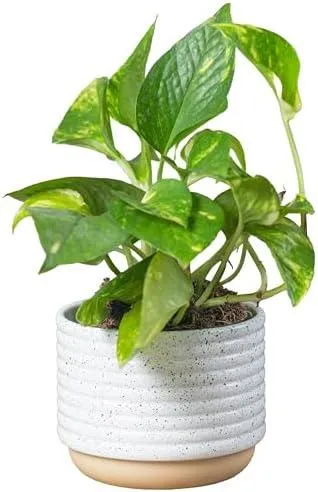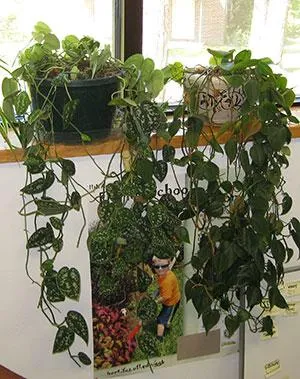The Best Long Vine Houseplants to Add Vertical Interest to Your Home
If you’re looking for plants to climb walls, drape from hanging baskets or trail along shelves, long vine houseplants are perfect additions to bring height and visual appeal to any indoor space. From my experience caring for dozens of vining plants over the years, here are some top options to consider.
Pothos (Epipremnum aureum)
Pothos is perhaps the ideal beginner climbing plant due to its sturdiness and tolerance of low light conditions. Its trailing stems can extend several feet in length as it climbs walls and furniture, sprouting heart-shaped green or variegated leaves along the vines. I’ve had success training pothos up poles, around picture frames and draping plants from hanging pots on my patio. It grows quickly without fuss.Pothos is practically impossible to kill!
Philodendron (Philodendron spp.)
This genus includes over 500 species in forms ranging from ground-covering to delicate climbers. Two great vining options are heartleaf philodendron (Philodendron cordatum) and Brazilian philodendron (Philodendron hederaceum). Their thick, glossy leaves come in solid greens or featuring whites stripes and fenestrations. In my experience, philodendrons prefer moister soil and higher humidity than pothos. Stake them on a moss pole or trellis for extraordinary vertical foliage display.
English Ivy (Hedera helix)
This enduring classic vine has small, dark green leaves that change color in low light. English ivy can climb sheer surfaces like no other houseplant, covering almost any texture it encounters. However, be aware that its sucks can damage paint and wallpaper if not contained. Best grown in a hanging basket or trained up a moss pole, English ivy thrives in a variety of conditions and makes an evergreen statement.
Silver Pilea (Pilea peperomioides)
Though not a true vine, pileas have stems that will cascade beautifully over the edges of containers if given support. Their round, flat-topped leaves resemble silver dollars, accented with contrasting purple undersides. Pileas multiply quickly through offsets and make an charming ground cover or hanging plant. An added bonus is that they’re pet-safe if ingested.

Chinese Evergreen (Aglaonema spp.)
With their colorful leaves splashed in hues of red, pink, variegated cream and green, Chinese evergreens brighten any indoor space. While not super prolific climbers, their arching canes covered in sturdy foliage have an elegant appearance draped over a shelf or basket’s edge. Chinese evergreens prefer medium light and humidity—misting their leaves help keep them lush. Rotating plants prevents legginess.
Silver Knight (Cissus rhombifolia)
This tropical vine boasts edgy, silver veined leaves and an ability to climb sheer surfaces quite rapidly using sticky pads. Silver knight vines look amazing trained up a materials like driftwood or draped over a hanging structure. They demand high humidity and prefer to dry out slightly between waterings. Silver knight is a bit pricier but well worth it for its stately tropical appearance.
Purple Wandering Jew (Tradescantia pallida)
With trailing stems covered in purple-tinged green leaves, wandering jew varieties inject lovely color into any setting. They thrive in low to medium light and will readily root wherever their stems touch the soil—providing an economical, spreading ground cover. Purple wandering jew handles average home conditions nicely. Snip cuttings to start new plants or share with friends!
Caring for Long Vine Houseplants
While vines tend to be very low-maintenance overall, here are some tips I’ve found helpful for growing them successfully indoors:
- Provide support for vines to climb. Moistened poles, wires, trellises or totems work well. Consider height and direction when placing.
- Hanging baskets or wall planters are great for draping types like pothos and philodendrons. Make sure to water carefully to avoid damage below.
- Use a well-draining potting mix for container grown vines. Check soil regularly and water when the top inch becomes dry.
- Most vines thrive in medium to low light. Rotate plants occasionally for even growth. Supplement sunlight in winter if possible.
- Trim vines to control their size, shape or to propagate more plants. Cut above nodes or leaf joints using clean shears.
- Mist foliage periodically for higher humidity lovers like Chinese evergreens and silver knight. Humidifiers help too, especially in winter.
- Fertilize monthly in spring and summer with a balanced, water soluble plant food to keep vines growing vigorously.
- Tie or weave vines gently to supports to prevent breakage as they elongate.
Real-Life Vining Houseplant Projects
Here’s a couple cool examples from my own collection that may give you some ideas for how to utilize climbing plants creatively indoors:

The Living Picture Frame
I trained golden pothos cuttings up bamboo stakes mounted behind an antique picture frame propped on a bookshelf. The vines now completely cover the bare frame area with lush foliage. It’s a unique, low-effort way to decorate. The pothos seems to enjoy the vertical real estate!
The Tropical Tree Trunk
Sort of a crazy idea that somehow worked—I bought a cheap artificial tree stump, spray painted it brown and attached clipping of silver knight, philodendron and tradescantia cuttings all over using floral pins. Mist lightly each week and it’s permanently decked with hanging vines like a mini jungle! Located it in a corner for visual impact.
Growing vines indoors offers unique creative possibilities to liven up blank walls and vertical spaces. With minimal care requirements, long trailing plants can potentially thrive forever, continuing to provide their natural decorating touch for years to come. Give one or two a try—you may get bit by the vine bug too!
Let me know if you have any other questions. Wishing you the best finding the perfect vining companion plant for your home. Happy planting!
Comparison of Common Long Vine Houseplants
| Plant | Maximum Height | Light Requirements | Water Needs | Notes |
|---|---|---|---|---|
| Pothos | 30 feet | Low to medium, tolerates low light | Allow soil to dry out between waterings | Very hardy, toxic to pets |
| Philodendron | 30 feet | Medium to bright indirect light | Water when top inch of soil is dry | Large heart shaped leaves, toxic to pets |
| Spider plant | 6 feet | Bright indirect light | Allow soil to partially dry between waterings | Produces plantlets on long stems, not toxic |
| Wandering Jew | 3-6 feet | Medium to bright indirect light | Water when top inch of soil is dry | Multicolored leaves, tolerate low light, toxic to pets |
| English Ivy | No limit, will climb | Bright indirect light | Water when top inch of soil is dry | Vigorous climber, tolerates low light, slightly toxic |
FAQ
-
What kind of soil do long vine houseplants need?
Long vine plants basically require soil that provides good drainage so their roots don’t sit in water. A potting mix with lots of small pieces like bark or perlite works well. On the other hand, soil that stays soggy can cause the roots to rot.

-
How much sunlight do they need?
Most long vine types like spots with bright, indirect sunlight. Direct sun can dry them out too quick. At the same time, they won’t grow very fast in low light. Aim to give them several hours of sunshine each day, if possible.
-
Do they need fertilizer?
You should fertilize long vines during the growing season from spring to fall. Use a houseplant fertilizer at 1/2 the dosage listed on the package every few weeks. Otherwise, their growth may be quite slow. However, go light on the fertilizer in winter when they’re not actively putting on new leaves.
-
How do you keep them looking their best?
Regular misting helps long vines look stunning. The moisture adds humidity around the foliage. You can also use a pebble tray by putting stones and water under the pot. Strangely, some people swear pebble trays improve their houseplantsuccess rate. In addition, pruning away any leggy or diseased parts maintains an attractive shape.
-
How do I encourage them to vine?
To kind of train long vines to grow outward, give them something to climb. Moisten a pole, trellis, or string and gently wrap the stems around it. Appears the plant responds to physical touch by putting out more growth in that direction. Routine training helps them form hanging baskets or curtains of foliage.
-
What common problems might they have?
Mealybugs and spider mites can be a real drag for long vines. Watch for fluffy white spots or tiny web-like creatures on the leaves and stems. In addition, overwatered soil might possibly lead to root rot. Check the soil feels dry before watering again. But is it worth it—the amazing foliage these vines offer?

